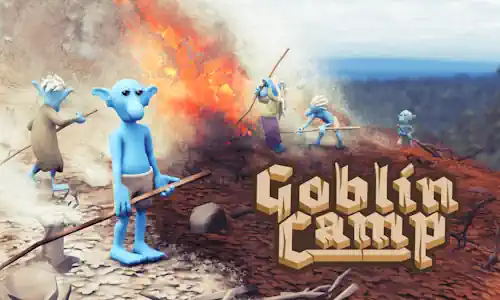Haven’t I seen you guys before?
You may well have! The original Goblin Camp appeared online in 2010 as a solo project by Ilkka Halila, now our CEO and CTO. Full disclosure: he is my younger brother. The previous iteration of Goblin Camp was a labor of love, and we’re grateful to everyone who joined our little community and pitched in. We had an active forum, fan-made tilesets, and just a great spirit. We both have fond memories of the project, and we’d like to welcome everyone who was in any way associated with it to join us for the second coming of Goblin Camp!

Like this one, the previous Goblin Camp was also a game about managing a settlement of goblins in the middle of a forest. The ASCII graphics let us deploy a pretty extensive variety of plants, monsters, buildings and all kinds of things, and we had fun with it. ASCII also felt very appropriate, because for both of us, that was where the road to Goblin Camp originally started.
Some time in what I think must have been 1993 or 1994, I received a copy of Nethack on a floppy disk from a friend. I think it must have been version 3.1.0, and I spent hours upon hours playing it. The combination of an intricately detailed dungeon and the ASCII graphics that let your imagination run riot was simply magical. The basic gameplay was great fun in itself, but what made Nethack even better was discovering first explore and then wizard mode. My brother took full advantage of wizard mode to roleplay actually living in Minetown, building a house for his character and everything. Both of us put in serious time in MS-DOS Editor, drawing ASCII maps of imaginary dungeons.
The roots of Goblin Camp are definitely in early-nineties ASCII, but other games also contributed. Some of our first experiences of proper multiplayer gaming also took place around 1994, when the original Warcraft came out, and we rigged a null modem cable between the two computers in our house. Although the goal of the game was to defeat the other player, we were both far too interested in building up the most epic fortified town possible, and therefore very early on banned catapults altogether! Other games that made an impact on us were Sid Meier’s Railroad Tycoon and SimCity, both of which were about managing dynamic systems.
As we both grew up, we took these interests in different directions. We had both learned to code at a very young age, because our father had made his career at Digital Equipment Corporation. Ilkka stuck with that and became a very successful programmer. I ended up studying history, and long before that, satisfied my gaming urges by running tabletop role-playing games. I have two campaigns running right now, and I can’t think of a better way to learn about designing games.
Meanwhile, video games just kept getting better. A real milestone in terms of our interests was Dungeon Keeper in 1997; one of the first successful games to take the traditional dungeon-delving adventure and turn it around, with the player taking charge of the dungeon, not the heroes trying to rob it. Basebuilding was becoming more involved in RTS:s, citybuilders were advancing, and online gaming was developing at a terrific pace. The idea of living, functioning communities in games wasn’t such a stretch any more.
A lot of these same influences then met in 2006, when Dwarf Fortress was released. As everyone knows, Dwarf Fortress basically started the current genre of city-building survival games. The most direct reason Goblin Camp was born was very simple: my brother had way too much free time as a university student when Dwarf Fortress came out. The success and undoubted brilliance of Dwarf Fortress is what pushed him, and subsequently us, to finally create Goblin Camp. It’s a great pleasure to return to this project now, when a whole genre has grown up around Dwarf Fortress. We hope we’re successful in taking this medley of experiences and infuences, and forging it into a fun game.
